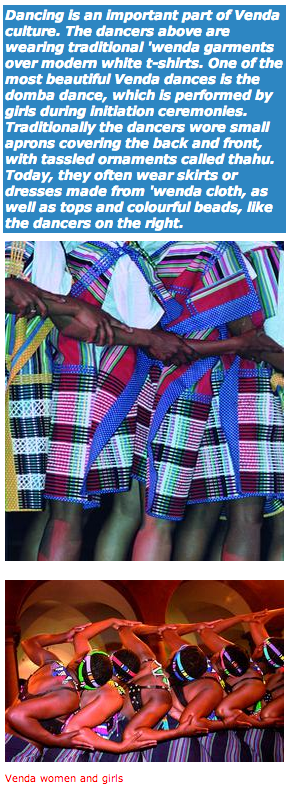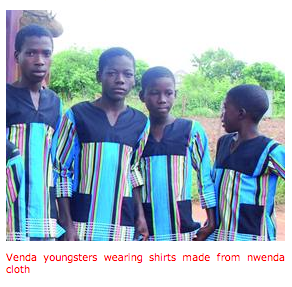VENDA TRADITIONAL DRESS
VENDA TRADITIONAL DRESS sadminCELEBRATING OUR HERITAGE
VENDA TRADITIONAL DRESS
Venda women and girls
The most colourful part of Venda women's clothing is the upper garment made from multi-coloured striped cloth called 'wenda. It is a length of cloth with a strip (bannda) sewn on across the top and two straps (mivhofho) of the same cloth to tie over the shoulder.
A traditional garment which was worn only by married women, is a goat skin apron called tshirivha, covering the back and front. On special occasions, married women used to wear a ceremonial back apron made of sheepskin called gwana. Today, a similar garment is made of 'wenda cloth. Maredo, worn by young females, are narrow strips of cloth hanging between the legs over a girdle in the front and back. Bracelets and necklaces of twisted grass called vhukunda were worn by females for decoration. Young women also wore pieces of copper twisted round a string of cotton, called thuthu or shedo, round the ankles and wrists.
Venda men and boys
A loin cloth called tsindi is an important item of clothing traditionally worn by all Venda males. It is a triangular piece of soft skin covering the front, passed between the legs and tied at the back. Tsindi worn by mature men were made from the skin of a goat, klipspringer or duiker. A rope called ludede was worn around the waist. In cold weather, Venda men also wore a cloak over the shoulders called nguvha. It was usually made by young men from a complete goat's skin. The chief traditionally wore an animal skin headband and a karos or sila over his shoulders.
Today, Venda men often wear shirts made from the traditional striped 'wenda cloth. Sometimes they wear a length of 'wenda cloth tied across one shoulder.
- Information supplied by the University of Venda
